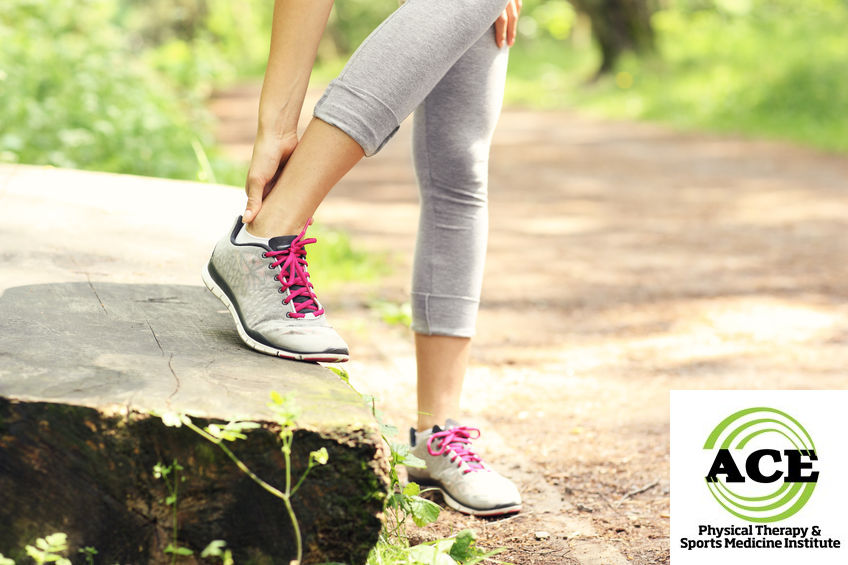HOW TO TREAT COMMON WALKING INJURIES
Preventing and Treating Common Walking Injuries
by ACE Physical Therapy and Sports Medicine Institute
Tid Bits of Info.
- Greater than 200,000 walkers are reported to be treated for injuries every year.
- The US population walks the least of all of the industrialized nations.
- Everyone should attempt to walk 10,000 steps per day.
- Most “walking shoes” should be replaced every 250-300 miles.
- Seek the advice and treatment of a Physical Therapist if an injury occurs or before you start a walking exercise program.
Walking offers a variety of health benefits for people of all ages. It can lower the risk of health problems, strengthen bones and muscles and even improve your outlook. As more people turn to walking for regular exercise, more people are also suffering walking injuries due to improper footwear, excessive walking or lack of proper conditioning. Walking injuries commonly impact the feet but can also affect other parts of the body. Most injuries can be avoided if you are properly prepared and outfitted with the correct gear.
Drawing from their formal education and practical experience with patients, Physical Therapists can help patients avoid walking injuries. The Physical Therapist will conduct a personal assessment of your walking gait and offer suggestions for an exercise program that will stretch and strengthen the core and lower extremity musculature and joints. The therapist can also suggest the proper type of shoe to wear, which may require an insert to add extra support to the foot/arch.
Common Walking Injuries
These are in no specific order and all are very treatable should they occur. Seek treatment or advice from a Physical Therapist about treatment if you sustain an injury.
Heel pain:
Heel pain is often due to the Plantar Fascia: a band of leather-like tissue that helps to support the medial longitudinal arch of the foot. The pain is usually on the bottom and can be very sharp at times. The first couple of steps upon getting out of bed in the morning are usually the most painful steps of the day. Often times the symptoms are described as a pebble in the shoe.
Achilles tendon pain:
The Achilles tendon is the large “cord” like structure that attaches to the back of your heel. It is attached to the calf muscles and is responsible for pulling the heel off of the ground during gait. The repetitive nature of walking requires the tendon to be active on every step. Should someone walk excessively or on abnormal terrain this tendon can be over-used and develop tendinitis. The anatomy of the foot and the strength of the entire leg can put excessive force on the Achilles tendon during gait if the foot pronates too much and/or the strength of the leg is not sufficient to control the motion of the joints throughout the leg and its entire kinetic chain.
Shin Splints:
The muscles of the foot and ankle originate (attach) to the bones in the shin or the Tibia and Fibula. The muscle contract to move or control the bones and joints of the foot and ankle during walking. If there are too many forceful contractions or too many contractions in a given period of time and the muscles are not able to handle the stress and strain, they will be injured. If the injury occurs in the tendon area of the origin, it can develop into shin splints. This is described as micro tears of the tendon or a form of tendinitis. The primary locations are along the anterior, lateral side of the Tibia or more commonly a posterior, medial location of the distal Tibia. This is the location that originates several muscles that help to control or move the medial longitudinal arch. The Posterior Tibialis muscle is the primary muscle that is effected when there is too much pronation during walking.
Lumbar Spine pain:
The core muscles help to control every motion that is made during life. The lumbar spine is no exception and requires significant muscle support (dynamic) to remain pain-free. During walking, the lower extremities form a kinetic chain of motion. If one area is not moving properly or moving abnormally, there can be added stress and strain to the lumbar spine. If the muscles of the spine are not able to handle the added forces and stresses, they can be injured. The effects of gravity play a role and the dynamic support helps to control the effects of gravity. If the muscles are unable to provide the proper support to the lumbar spine the joints of the spine can become inflamed and damaged.
Blisters:
Ill-fitting shoes can lead to abnormal “rubbing” or friction on the skin and cause blisters. When these occur they can lead to significant pain which can cause you to change the way you walk. Any time your gait is not “normal” the added stress and strain placed on the different joints and soft tissues of the lower extremities and lumbar spine can cause a compensatory injury in that area.
Physical Therapists can help prepare you for a walking program or treat an injury that occurs when one develops from walking too much. The preparation for a walking program consists of a sound stretching and strengthening program for the core and lower extremities. The Physical Therapist can assess your gait and determine if you have need for shoe inserts. These inserts can be simple “over-the-counter” or custom orthotics. The inserts are designed to help prevent abnormal foot motion which can cause injuries to occur throughout the lower extremity or kinetic chain.
If an injury does occur, the first treatment option is to follow the RICE principles of acute injuries. These principles are: Rest, Ice, Compression, and Elevation if the injury site is inflamed or swollen. If this treatment approach does not reduce and resolve the symptoms, several treatment sessions with the Physical Therapist can usually “cure” the injury and enable your return to pain-free walking.
Walking is usually a very safe exercise routine or way of transportation, but if the activity is performed in excess or with improper fitting shoes an injury can occur. Proper preparation can prevent injuries from occurring. If walking injuries do occur, seek the advice and treatment from a Physical Therapist to ensure a speedy recovery.
Read more articles on our main website blog at: ACE-pt.org/blog
Vist our main website at www.ACE-pt.org


